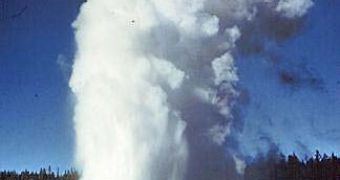Islanders blamed them on the witchcraft, the Inca on the spirits of the ancestors. Geysers are a type of hot spring that erupt periodically, ejecting a column of hot water and steams into the air. Their emergence needs a combination of factors (water, heat and fortuitous plumbing) that exists in only a few places on Earth, and so they are fairly rare phenomena. Moreover, they are instable and short-lived. There are about 1,000 worldwide. A geyser is like a volcano, having a cone and a small crater (called basin or reservoir, tens of meters long), as it is refilled with water warmed up to 140oC by the lava below after each jet. Normally, water turns into vapors at such temperature, but the high pressure maintains it liquid (the vapor would occupy a volume 1,500 larger than that of the liquid water). The crater is connected to a canal which can be several meters wide. Hot water under pressure circulates through this canal coming from the inner crust of the Earth. When the pressure and the temperature get too high, a new column of hot water gets out.
Geyser water can come from rainfall and snowfall penetrating through the cracks to volcanic rocks but it could also result from the condensation of the vapors produced by the magma. The hot temperature of the water is due in all cases to molten magma located a great depths. The solid deposits forming the cone are called geyserite.
1.Perhaps the most amazing thing in Yellowstone National Park is represented by these hot artesian springs, the geysers. This is the largest geyser field in the world! Yellowstone has about 500 geysers: half of all the geysers in the world! And 300 are really spectacular.
The currently largest geyser is found here: Steamboat, 120 m (400 ft) tall. But the most famous geyser of Yellowstone is the Old Faithful, with extremely precise 60 m (200 ft) tall eruptions, at 30-82 minutes. Other famous geysers of the area are tge Giant Geyser, which pushes water up to 61 m/203 ft, with a temperature of 94.8o C; the Lone Star Geyser, the Norris Geyser and others.
2.The second largest geyser field in the world, found in Kamchatka (Russia) is much smaller than that of Yellowstone: Dolina Geiserov ("Valley of Geysers"). This is the only place on continental Eurasia where geysers are encountered. In Kamchatka geyser field there are 34 big jets (20 m or 66 ft tall for 5-10 minutes) and 200 smaller thermal springs (jetting to 2 m (6.6 ft)) in a 2.7-square-mi (7-square-km) area. The water of this geysers has a temperature of 80o C.
The famous valley, part of the Kronotsky Nature Preserve, was buried, on June 3, after an entire mountainside collapsed. It has literally disappeared in a minute. If the river blockage is not broken, the valley could turn into a large heated lake.
Tourists visiting the uninhabited valley were lucky: a group of 19 barely escaped alive from the disaster, as the debris stopped less than 3 ft (1 m) from their helicopter and the buildings they were housed in.
Geyser River, which ran freely through the valley once, filled it with millions of gallons of rock, gravel, snow and ice.
3.Iceland has more than 200 geysers whose waters reach temperatures over 90o C. The name "geyser" comes from the Icelandic region called Geyser and in Old Icelandic language it means "to spring". 70 km (42 mi) off Reykjavik the Strokkur geyser is found. It is 20 to 40 m (66 to 133 ft) tall and its frequent eruptions last 20 minutes each.
Iceland is the first country in the world taking advantage of the geyser heat since 1910 for warming up dwellings. Today, Iceland uses geyser water for cultivating tropical crops in greenhouses (even bananas!), on the latitude of the Polar Circle.
The most famous geyser of Iceland is the Great Geyser, which, when resting, appears like a lake of 18 m (60 ft) in diameter and 3-4 m (10-14 ft) deep, and, when erupting, it gushes water jets 54 m (180 ft) tall for 10-15 minutes, at a temperature of 80-82o C. The jets take place at 25-30 hours distance. The canal mouth is 3 m (10 ft) wide. Its cone is made of silicon concretions. At 12 m (40 ft) deep into the canal, the water has a temperature of 121o C, but it does not boil because of the pressure of 2 atmospheres.
4.Other places on Earth where isolated geysers are found are Chile, New Zealand, California, Peru, Ethiopia, Bolivia, Dominica, Azores, Kenya, Java and Japan.
The largest known geyser functioned in New Zealand between 1899-1904: "Waimangu" ("Black Water" in Maori language) had a water column of 800 cubic meters of boiling water and 457 m (1,523 ft) tall, twice than Eiffel Tower! New Zealand too uses the energy from its around 20 geysers.

 14 DAY TRIAL //
14 DAY TRIAL //